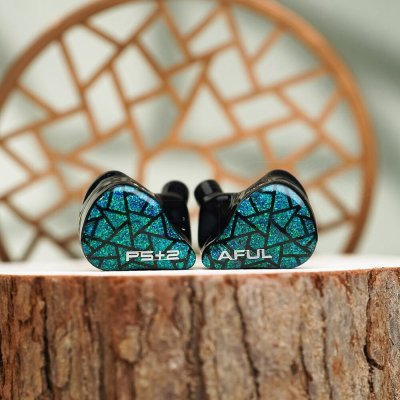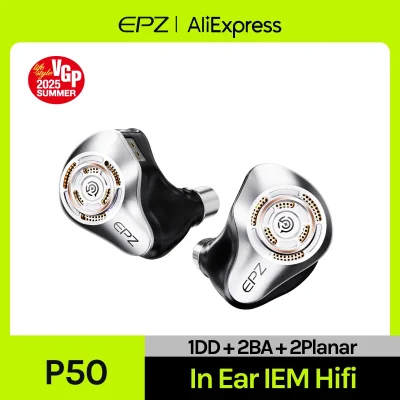Aful Performer 5+2 and EPZ P50 use 2DD+4BA+1Planar and 1DD+2BA+2Planar driver setups respectively. Aful Performer 5+2 costs $229 while EPZ P50 costs $205. Aful Performer 5+2 is $24 more expensive. Aful Performer 5+2 holds a slight 0.4-point edge in reviewer scores (7.7 vs 7.2). EPZ P50 carries a user score of 9.5. Aful Performer 5+2 has significantly better dynamics with a 1.1-point edge, EPZ P50 has better details with a 0.7-point edge and EPZ P50 has better imaging with a 0.5-point edge.
Insights
| Metric | Aful Performer 5+2 | EPZ P50 |
|---|---|---|
| Bass | 8 | 8.1 |
| Mids | 8 | 8.2 |
| Treble | 7.6 | 7.7 |
| Details | 7.6 | 8.3 |
| Soundstage | 7.8 | 7.6 |
| Imaging | 7.9 | 8.4 |
| Dynamics | 7.6 | 6.5 |
| Tonality | 7.8 | 7.3 |
| Technicalities | 7.7 | 7.3 |
Aful Performer 5+2 Aggregated Review Score
Average Reviewer Scores
Average Reviewer Score:
7.7Strongly Favorable
EPZ P50 Aggregated Review Score
Average Reviewer Scores
Average Reviewer Score:
7.2Generally Favorable
Reviews Comparison
Aful Performer 5+2 reviewed by Jaytiss
Youtube Video Summary
Aful Performer 5+2 lands as a hybrid of the beloved Performer 5 and the punchier Explorer. The unboxing is the familiar P5 affair—same case, same style of tips—nothing flashy, but solid. The shell mirrors the P5 in size with a comfy little stabilizing wing that locks in well. No metal nozzle or front filter here, yet tip retention is secure and hassle-free. The flat 2-pin socket is straightforward, and the stock cable feels thick and supple with a reliable chin slider and handy red/blue channel markers. Overall: understated build, great ergonomics, daily-driver ready.
Sonically, this one aims neutral with a very distinct top end—clean, dynamic, incisive. Think switching from black-and-white to color; cymbals and overtones pop with a slightly crunchy/pristine edge that energizes detail without turning harsh on good recordings. Bass isn’t about sheer quantity; it’s about slam and dynamics—quick on the draw, well-controlled, and satisfying when called upon. Vocals sit a notch forward, microdetail is strong, and the overall presentation is coherent, clear, and technical with convincing stage, resolution, and imaging. Not a treble-shy or bass-bombed tuning—more a refined all-rounder for those who want clarity and bite.
Versus the original P5, the 5+2 fixes the missing “air” and soft edges, trading them for crisper transients and better extension. Compared with Explorer (a value champ), the 5+2 brings superior upper-treble reach, detail, and vocal focus. Against Performer 8 and Cantor, it feels more visceral—the P8 is smoother and more relaxed, while Cantor pulls finer microdetail but with less bass slam. Sets like Dino Quattro or J’s Estrella bring bigger fun or treble theatrics, yet the 5+2’s balance and everyday versatility win more often. Net take: a neutral-leaning, highly technical upgrade that stands tall in its bracket—easy to recommend to anyone chasing clarity, speed, and controlled impact over pure warmth or excess bass.
Jaytiss Youtube Channel
Buy Aful Performer 5+2 on HiFiGO
Ad
Price: $213
Buy Aful Performer 5+2 on HiFiGO
EPZ P50 reviewed by Jaytiss
Jaytiss Youtube Channel
Buy EPZ P50 on Aliexpress
Ad
Price: $199
Buy EPZ P50 on Aliexpress
Aful Performer 5+2 reviewed by Audio Amigo
Youtube Video Summary
The AFUL Performer 5+2 (Performer 7 / P7) takes the P5 recipe and adds a second 6 mm dynamic for the lows and a micro-planar for the highs, nudging MSRP to $240. Unboxing mirrors the P5: nine pairs of tips and a decent case, but the accessories feel bare-bones at this price—no foam tips and a non-modular cable, even though the included 8-wire is supple and well-behaved. Build is classic AFUL: 3D-printed resin, blended nozzle (no mesh or lip—watch tip retention), single rear vent, and striking blue-green mosaic shells inspired by Suzhou gardens—cool-wall approved with four compliments to one “meh.” Fit is semi-custom and a touch chunkier than P5; comfortable for most, a conditional pass for small ears. Note a sporadic batch quirk: some units have over-tight 2-pin sockets; exchanges fixed it for affected buyers.
Tuning sits in warm-leaning neutral territory. The dual dynamics deliver punchy, textured bass that rumbles without bloating; guitars and drums carry convincing weight. Mids are the star—rich, full-bodied, vocal-forward without shout, with clean separation and natural tone. Treble from the micro-planar is smooth yet energetic: cymbals and vocal harmonics sparkle, special effects have bite and body, and only treble-sensitives may find hot mixes a bit lively. Technicalities impress for the money—detail retrieval and nuance feel a class up—while stage and imaging are solid rather than showy.
Against peers: the Tangzu x HBB budget pick mirrors the overall tonality but P7 offers higher resolution and more treble finesse; the planar “Heyday” alternative is brighter/faster with leaner bass; versus Performer 5, P7 brings tighter low-end, smoother treble, and better extremes detail; the Fresh-collab competitor pushes vocals further forward with bigger stage but leaner lower mids. Verdict: a versatile all-rounder that suits broad libraries and even content creation thanks to its balanced tonality and detail. Not for bassheads, trebleheads, or strict Harman-lean seekers, and the accessory pack/cable quirk holds it back from a slam-dunk. For roughly $240, though, it’s a brilliant, resolving upgrade in the AFUL line.
Audio Amigo Youtube Channel
EPZ P50 reviewed by Audio Amigo
Youtube Video Summary
EPZ P50 comes as a tribrid at $185 with a surprisingly complete kit: a sturdy leatherette case, modular 3.5/4.4mm terminations, three silicone tip sets, and a cleaning cloth. The resin shells are semi-custom with aluminum faceplates; comfort is generally good but anatomy-dependent, and the stock cable—while well finished—runs on the stiff side. A standout twist is the factory customization option (~$225 total for the “Grindphones” style), which notably doesn’t alter the tuning in any meaningful way. The set is easy to drive, shows minimal change with impedance adapters (a touch warmer/more vocal-forward), and avoids pressure issues thanks to smart internal venting.
Sonically, tuning sits as a controlled, mild V: bass is just north of neutral with pleasing texture and impact, mids stay clean with an engaging female-vocal emphasis, and treble adds airy sparkle without turning tizzy—though insertion depth can trigger length-mode variability for some ears. Technical chops impress at the price: detail retrieval punches up, imaging is precise with good separation, and stage reads average but coherent. Against peers, P50 feels more resolving than Kiwi Ears K4 (trades bigger bass/sparkle for better mid clarity), brighter and more vocal-present than the neutral-leaning Ziigaat Lush, and echoes a Dunu Da Vinci vibe with less bass. Verdict: tremendous value and a terrific pick for vocal-centric libraries—highly recommended to audition first if treble sensitivity or fit quirks are a concern.
Audio Amigo Youtube Channel
Aful Performer 5+2 reviewed by Super* Review
Youtube Video Summary
Aful’s Performer 5+2 upgrades the original hybrid with 2DD + 4BA + 1 micro-planar tweeter and lands around $240–$250. The unboxing is practical: three sets of silicone tips, a pocketable puck case, and a soft, nicely draping cable (available in 4.4 or 3.5), though the braid can look a bit loose and the pre-formed hooks run large. The resin shells shift between blue and green under different light; fit is medium-large, very stable, and comfortable once the right tips are found. Note the narrow nozzle without a retaining lip and partially exposed bores/filters—tip grip is key and a little care prevents ear-gunk ingress.
Tonally this leans mild V-shaped: a clean midrange with a confident bass boost, a touch of lower-treble presence for bite, and well-extended air up top. The result is more incisive and punchy than the original P5, with clearer on/off transients that aid separation and layering. Trade-offs show as a hint of gritty/plasticky treble texture on cymbals and brushes—not harsh, but less natural than ideal—while the bass stays tight and exciting.
Against Aful’s Explorer, this sounds brighter, more spacious, and more technical; Explorer plays warmer/denser with smoother treble but less openness. Versus the pricier Thieaudio Oracle MK3, tuning is broadly similar: Oracle is smoother and deeper with a softer attack, while the Performer 5+2 brings more snap and engagement for less money. As a modern mid-tier hybrid, it absolutely still has a place—energetic, spacious, and well-executed—earning a solid four stars.
Super* Review original ranking
Super* Review Youtube ChannelEPZ P50 reviewed by Super* Review
Youtube Video Summary
EPZ’s P50 feels like a breakout for the brand: a compact, medium-small shell with a vented faceplate that’s marketed as “open-back,” yet isolates like a typical IEM. The unboxing is tidy at this price—carry puck, a real microfiber cloth, and two sets of generic tips—while the modular cable (screw-lock swappable termination) is handy if a bit thin, stiff, and kink-prone; the 2-pin plug sits slightly proud of the socket and the “R” marking is visible on the outside. The long nozzle (~5.5 mm diameter) can push fit depth, so shorter tips (e.g., NF Audio-style) help; once set, stability and comfort are excellent. Overall build looks clean and modern, if a touch editorial compared with EPZ’s other shells.
Sonically, P50 embraces the current tilted diffuse-field “new meta” with a mostly neutral, natural presentation and a later-rising, sub-bass-centric lift that gives bounce rather than mid-bass thump. There’s a hint of extra presence around the 4–5 kHz region that adds macro-contrast—vocals pop with definition and separation is crisp—while upper treble stays safe: cymbals are clean but a bit light in weight. Bass is tight and incisive rather than slammy; micro-texture on vocals is good, though the set favors that big, “stagey” contrast over ultra-fine grain. It’s easily EPZ’s best tuning so far: clear, organized, and engaging without drifting from neutral-ish aims.
Against peers, Kiwi Ears K4 tracks a similar target but sounds lower-contrast and can blur on dense mixes; P50 hits harder on transients, images more cleanly, and keeps busy tracks sorted, while K4 offers a richer midrange with “frothier” treble. Versus the Binary Chopin, Chopin is warmer, fuller, and more mid-bass driven—more “analog” and atmospheric—with deeper perceived space but a bulkier fit; P50 is leaner, clearer, and the least bass-forward of the three. Verdict: a confident 4/5 for delivering a small, comfy fit and a clean, contrasty neutral that competes squarely around $200–$250. If the brief is “neutral with a bit of drama,” this is a strong pick—and a promising sign of where EPZ can go next.
Super* Review original ranking
Super* Review Youtube ChannelAful Performer 5+2 reviewed by Kois Archive
Kois Archive Youtube Channel
EPZ P50 reviewed by Kois Archive
Youtube Video Summary
The EPZ P50 arrives as a ~$200 tribrid with a slick presentation: FR graph on the box, a puck-style case, plenty of tips (oddly two identical sets), and a nice microfiber cloth. Build leans premium with a semi-open back and a faceplate that gives “arc reactor” vibes. The custom shell offers a secure fit for most, though very small ears—or anyone sensitive to an inner wing—may need caution. The modular cable (3.5/4.4 mm) is practical yet slightly stiff and retains some memory; isolation is typical of sealed IEMs despite the semi-open styling.
Sonically, the P50 goes for a warm-balanced tuning. Bass quality impresses: bouncy with deep sub-bass reach, prioritizing texture and control over sheer quantity (more thump is possible via an impedance adapter). Mids read natural with a touch of warmth—male vocals shine—while female vocals can feel a bit lean due to a more relaxed upper-mid energy. Treble is smooth, inoffensive, and “planar-clean” without planar timbre, with only a slight wish for more top-end extension.
Technical performance is the star. The micro planars pull out micro-detail unusually well for the price; imaging, separation, and overall resolution feel confidently executed, making guitars pop and busy mixes easy to parse. That clarity translates to gaming, where positional cues and crowded soundscapes (think battle royale chaos) remain intelligible—worthy of a two-controller gaming nod. Overall, the EPZ P50 is a solid contender at this price: balanced tuning with standout detail retrieval and imaging, tempered only by mids that play it a little safe. For listeners unbothered by a gentler upper-mid lift, it’s well worth the money—a two-star recommendation.
Kois Archive Youtube Channel
Aful Performer 5+2 reviewed by Gizaudio Axel
Gizaudio Axel original ranking
Gizaudio Axel Youtube ChannelEPZ P50 reviewed by Gizaudio Axel
Aful Performer 5+2 reviewed by Tim Tuned
EPZ P50 reviewed by Tim Tuned
Tim Tuned Youtube Channel
Aful Performer 5+2 reviewed by Jays Audio
Youtube Video Summary
Performer 7 lands with a neutral-balanced, laid-back tuning and good treble reach. The presentation is clean and generally safe, though there’s a touch of sizzly “planar-ish” timbre up top. Technicals are solid for ~$200—slightly behind sets like Quintet and Super Mix 4, about on par with Nova. Bass from the dual 6 mm DDs is tight, controlled, and free of bleed, but lacks the slam and rumble of competitors using larger drivers; mids are well separated with decent layering.
The weak spot is vocal extension: a push around 1.5 kHz tries to bring them forward, but a dip through 3–6 kHz keeps them from opening up. Tamer upper-mids help avoid fatigue for rock/metal, yet the modest low-end impact leaves drums and basslines feeling uneventful. It’s a mid-volume set that doesn’t scale well—turning it up accentuates the 1.5 kHz emphasis and treble sizzle. Treble isn’t peaky, just a bit glassy at times; for K-pop the smoother mids can work if less extended vocals are acceptable.
As a value play, there are stronger options: Nova, Chopan, and Super Mix 4 offer better bang-for-buck; for a similar clean/neutral target, Tanchjim Origin sounds more natural with better bass texture and vocal reach, and DynaQuattro adds sub-bass and fuller vocals—none with the planar-ish timbre. Even AFUL’s own P5 is cheaper and more fun, while the Explorer undercuts the price and scales impressively. In today’s crowded market, P7 is a competent all-rounder but not distinctive enough to stand out.
Jays Audio Youtube Channel
EPZ P50 reviewed by Jays Audio
Youtube Video Summary
The EPZ P50 comes in hot as a new tribrid and a potential $200 neutral benchmark, trading sterile restraint for a more vocal-centric presentation. Versus the MEGA5EST, vocals sit a touch more forward—adding emotional weight and clarity—while the MEGA5EST still edges it on sheer smoothness and EST “air.” Compared to Meteor, the P50 fills in the lower mids, dials back 1–3 kHz glare, and opens the top end a bit; Meteor stays a hair softer up top. The catch is bass: the P50’s DD is competent but not a sub-bass shaker—expect clean rather than authoritative slam.
Against peers, the P50 sounds fuller and more natural than Supermix 4 (which is brighter and more “hi-fi” energetic), and it trades blows with Odyssey: Odyssey brings better bass texture and treble micro-detail, while the P50 delivers superior vocal clarity and a touch more air. It excels at mid-volume listening—Volume S needs more gain to bloom—and outclasses lighter, air-tilted sets like “K4” style tunings when male vocals or body are the priority. Accessory game is strong too: a nicer cable and a genuinely sturdy hard-leather case sweeten the deal. Not the most “unique” flavor and not for bassheads, but as a balanced, clean, vocal-forward option around $200, P50 is an easy recommendation for those chasing neutrality without the vanilla.
Jays Audio Youtube Channel
Aful Performer 5+2 reviewed by Web Search
2025-09-07The AFUL Performer 5+2 (also listed as “Performer 7”) uses a 2DD+4BA+1 micro planar driver array and AFUL’s LC-network crossover plus a 3D-printed acoustic tube system, aiming for clean band splits without smearing. The shell also integrates a high-damping air-pressure balance system, a design AFUL has used across its line. Official listings put MSRP around $229 and outline the same core tech features.
Tonally it trends neutral with a sub-bass lift: bass has solid depth and texture, mids stay relatively linear, and the presence/treble region adds energy without veering into sharpness on most chains. Multiple reviews characterize it as warm-neutral with bass boost or slightly V-shaped depending on perspective, which matches listening notes about a lively but controlled upper end. Sensitivity and load are portable-friendly (≈109 dB, 15 Ω), so it reaches performance without demanding amplification.
Technicalities are competitive for the class: imaging is tidy with good instrument separation, micro-detail retrieval is above average, and soundstage is moderate (more width than depth). Build and comfort are typical resin-shell fare; some users note occasional lower-treble bite depending on tips and recordings, so treble-sensitive listeners may wish to pair accordingly. Overall value is strong at its price, especially if a clean, bass-supported neutral curve is the priority.
EPZ P50 reviewed by Web Search
2025-10-03The EPZ P50 is a tribrid with a 10 mm dynamic driver, two balanced armatures, and two micro planar drivers, implemented in a semi-open back shell and a three-way crossover—an uncommon configuration at this price tier. Listings and spec sheets place impedance at 20 Ω and sensitivity around 106 dB, with interchangeable 3.5/4.4 mm plugs and 0.78 mm 2-pin connectors, positioning it as a flexible daily-carry IEM near the $200 mark.
Subjectively, multiple reviews converge on a neutral-with-bass-boost presentation: sub-bass is tight and weighty when called for, mids stay clear and slightly forward, and treble is extended with extra energy from the planar tweeters. This yields a clean center image and articulate vocals without obvious mid-bass bloom, though the upper-treble emphasis can read “sharper” on some recordings.
Technical performance is competitive for the class: reviewers note solid imaging, above-average separation, and a stage that feels wider than typical sealed IEMs—qualities plausibly aided by the semi-open design and multi-way damping. Trade-offs include reduced isolation versus closed shells and a treble tilt that may fatigue treble-sensitive listeners at high volumes, but overall resolution and micro-detail retrieval punch above its price.
Aful Performer 5+2 (more reviews)
Aful Performer 5+2 reviewed by Z-Reviews
Youtube Video Summary
Naming drama aside (P5+2? just call it Performer 7), this Aful packs a quirky driver party: 2DD for low end, 4 BA split across mids/treble, plus a tiny micro-planar for the highest sparkle, all marshaled by Aful’s neat miniature crossover. The shells are lightweight, comfy and prettier than they need to be; the cable feels “don’t bother swapping” nice, with 3.5 or 4.4 options. The box is loaded with silicone tips but no foam—a miss, because the right seal changes everything. Price target sits around $250, which sets expectations high but not ridiculous.
Stock silicone yields a surgical, respectful tuning with bass that skews neutral and controlled. Swap to well-sealing foam or hybrids and feed a juicy source (warm Class A or tubes) and the set wakes up—stage snaps into a cohesive scene right in front, imaging gets laser-etched, and that micro-planar adds a pinch-of-salt treble spice without turning harsh. It’s an up-close presentation—sometimes almost claustrophobically detailed—in the best way: think “men with trumpets in the head,” precise placement, and excellent extension up top. Not as rowdy as the Explorers; more like a surgeon in a Hawaiian shirt—technical, but with a wink.
Practical upside: the clarity and positioning make this great for gaming and even viable for mixing/mastering checks; just don’t crank it into pain territory. Bass stays tight and responsive, treble sails high, and coherence holds. Tip and source matter a lot: with foam + warm power, it sings; with plain silicone, it’s merely polite. Final tally: a confident 8.5/10—doing a lot right at its price, dinged half a point for making everyone do math on the name.
Z-Reviews Youtube Channel
Aful Performer 5+2 reviewed by Audionotions
2025-09-28EPZ P50 (more reviews)
EPZ P50 reviewed by Head-Fi.org
Aful Performer 5+2 Details
Driver Configuration: 2DD+4BA+1Planar
Tuning Type: Neutral with Bass Boost
Brand: AFUL Top AFUL IEMs
Price (Msrp): $229
Support our free service! Buying through our affiliate links costs you nothing extra:
EPZ P50 Details
Driver Configuration: 1DD+2BA+2Planar
Tuning Type: Neutral with Bass Boost
Price (Msrp): $205
Support our free service! Buying through our affiliate links costs you nothing extra:
Aful Performer 5+2 User Review Score
Average User Scores
Average User Score: n/a
Based on 0 user reviews
No user reviews yet. Be the first one who writes a review!
EPZ P50 User Review Score
Average User Scores
Average User Score:
Based on 1 user reviews
9.5Exceptional
Aful Performer 5+2 Gaming Score

Gaming Score & Grade
- The gaming score is prioritizing technical capabilities of the IEM (Separation, Layering, Soundstage) and good value.
Gaming Score
7.7Gaming Grade
AEPZ P50 Gaming Score

Gaming Score & Grade
- The gaming score is prioritizing technical capabilities of the IEM (Separation, Layering, Soundstage) and good value.
Gaming Score
7.3Gaming Grade
A-Aful Performer 5+2 Scorings
Average Technical & Tuning Grades
Average Tunign Grade
A- Tuning feels well executed, keeping a natural flow across the spectrum. Switching genres feels seamless.
Average Technical Grade
A- Overall technical control is strong, presenting instruments with clarity and sensible staging. Textures are portrayed with satisfying clarity.
EPZ P50 Scorings
Average Technical & Tuning Grades
Average Tunign Grade
A-- The tonal character feels settled and versatile, with just a few gentle bumps. You can listen for hours without fatigue.
Average Technical Grade
A-- You get a controlled, composed performance, marrying decent clarity with a still-modest sense of space. A safe technical performer for the price bracket.
Aful Performer 5+2 User Reviews
"This is an example review"
Pros
- Example pro 1
- Example pro 2
Cons
- Example con 1
- Example con 2
Share your experience and build your personal ranking list.
You need to be signed in to write your own reviewEPZ P50 User Reviews
Share your experience and build your personal ranking list.
You need to be signed in to write your own reviewKillabuck.
Pros
No roughness, Natural timbre, Balanced signature, good note density, Very good consistency, comfortable to use, Good cable, Technically amazing, good accessories, good tips, good transparency, good brightness, tactile bass, not much warmth, nice voices.Cons
None.Find your next IEM:
IEM Finder Quiz
newIEM Comparison Tool
newVS
























